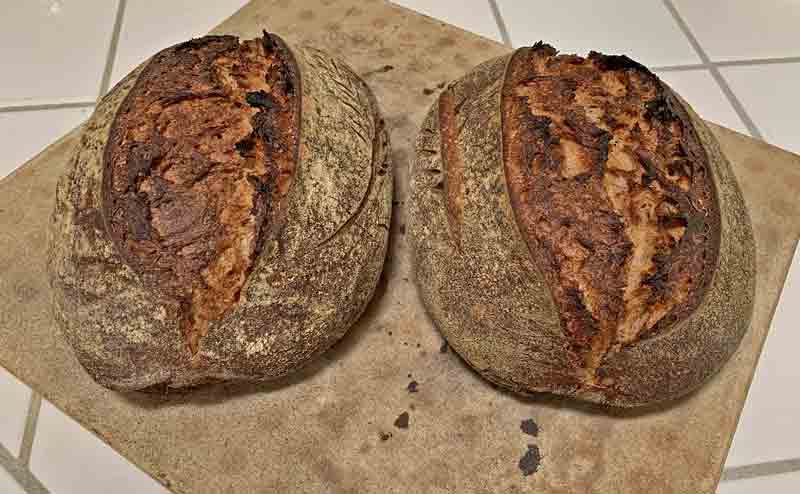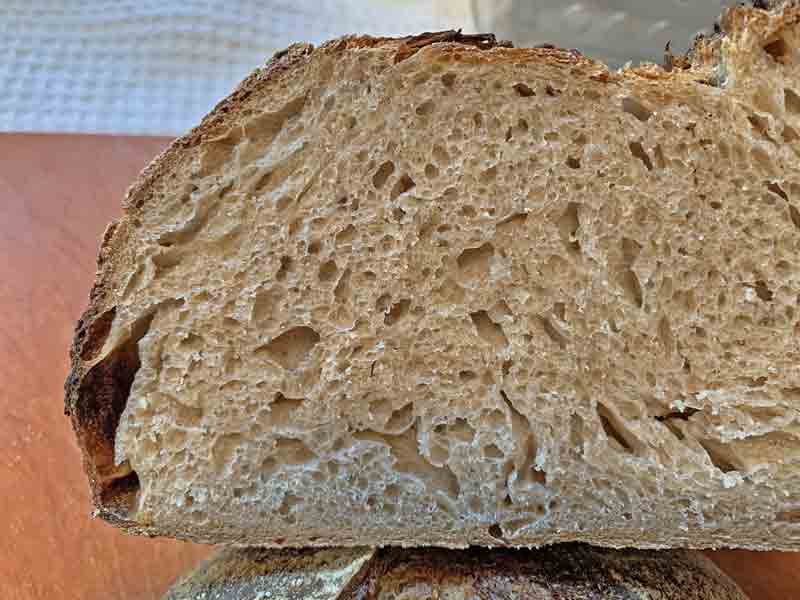
Multi-grain Sourdough Bread: April 30, 2019

Sourdough Bread: April 30, 2019
David Snyder
This is basically the same bread I baked on March 22, 2019. The only change was to substitute spelt for the rye and some of the all purpose flour in the final dough.
I have been trying different grain blends and anticipate continuing this line of experiments for a while. All the breads have been among my favorites. The long cold retardation really enhances the acid content without resulting in too much gluten breakdown, at least with these flours and this hydration level.
Total Dough |
|
|
Ingredient | Wt (g) | Bakers' % |
High-protein flour | 147 | 13 |
AP flour | 653 | 56 |
Whole Rye flour | 136 | 11 |
Whole Spelt flour | 234 | 20 |
Water | 769 | 65 |
Salt | 23 | 2 |
Total | 1962 | 167 |
Starter |
|
|
Ingredient | Wt (g) | Bakers' % |
High-protein flour | 110 | 88 |
Whole Rye flour | 15 | 12 |
Water | 62.5 | 50 |
Firm starter | 62.5 | 50 |
Total | 250 | 200 |
Dissolve the starter in the water.
Add the flours and mix thoroughly.
Ferment at 76ºF for 8-10 hours.
Refrigerate for 12 hours or up to 3 days.
Final Dough |
|
Ingredient | Wt (g) |
AP flour | 653 |
Whole Rye flour | 116 |
Whole Spelt flour | 234 |
Water | 686 |
Salt | 23 |
Starter | 250 |
Total | 1962 |
Procedures
Place the flours and water in the bowl of a stand mixer and mix at low speed to a shaggy mass.
Cover the bowl and let it rest (autolyse) for 1-2 hours.
Sprinkle the salt over the surface of the dough. Add the starter in chunks. Mix at Speed 1 for 2 minutes to distribute ingredients then for about 9 minutes at Speed 2 to develop the dough.
Transfer the dough to a lightly floured board. Shape into a ball.
Transfer the dough to a clean, lightly oiled bowl. Cover the bowl and ferment at 80ºF for about 3 hours with stretch and folds at 50 and 100 minutes.
Divide the dough into two equal pieces. Cover and let rest for 10-30 minutes to relax the gluten.
Shape as boules or bâtards and place in floured bannetons. Cover or place in food-grade plastic bags.
Proof for 2-3 hours at room temperature until the loaves have expanded by about 50%.
Refrigerate for 12-40 hours (The longer the cold retardation, the more sour the final loaf).
Remove from refrigerator. Check on degree of proofing. Proof further at 80ºF, as needed. (May need 1-3 hours.) If adequately proofed, proceed to scoring and baking.
Transfer to a peel. Score as desired.
Bake: If baking in Dutch oven, bake at 475ºF covered for 20 minutes, then uncovered at 450ºF for another 10 minutes or until done to satisfaction.
Bake: If baking on the hearth, pre-heat oven at 500ºF for 1 hour with baking stone and steaming apparatus in place. Turn down oven to 460. Load loaf and steam oven. After 15 minutes, remove steam and continue baking for 20-35 minutes, until loaf is baked. (Depends on size and shape of loaf.)
The bread is done when the crust is nicely colored and the loaf sounds hollow when thumped on the bottom. The internal temperature should be at least 205ºF.
Transfer the bread to a cooling rack and cool thoroughly before slicing.
Today's loaves were cold retarded for 36 hours then proofed at 80ºF for about 60 minutes before being baked.


This bake was quite similar to others in this series. The crust was crunchy. The crumb was mildly chewy. The flavor was complex and very nice with a definite acetic acid tang that did not over-power the flavor of the grains.
Happy baking!
David


Comments
You are really on to something with the extended cold retard. The sour must be very interesting. I have been exploring the sour with the " old" unrefreshed levain. So far day 5 and day 12 were both still quite good and the bread turned out great with almost no handling and using the old levain produced a nice light sour flavor. My favorite part of the bread is the paper thin crisp light crust. We have enjoyed wonderful grilled cheese on it as well as grilled bread with a pasta dinner. It has a very rye taste. I am using one of your multigrain formulas as a base to start. Next week will be a day 19 unfed starter. I got the idea from Mike on Perfect Sourdough . I know you have communicated with him about the sour flavor profile.
Hope all is well with you and your family. Miss your brother Glen's bakes ! c
We're well, thank you.
AFAIK, Glenn is still baking, but maybe not as much as my sons. And I just learned that my grandson, who is finishing his freshman year in college, wants to live off campus next year, because he misses being able to cook. Apparently the culinary drive gene, or whatever it is, breeds true.
David
So glad you are passing along the love of cooking/baking. Our grandson at 7 always loves a chance to get into the kitchen with anyone that will have him LOL ! Our son the chef, his dad , has a new gig as a fraternity chef here in Lexington VA. For Mardi Gras celebration he smoked a WHOLE alligator !! Our grandson helped him with some of the prep...removing some of the guts. He posted some great pics on his facebook page.
Look forward to your next bake. c
As usual a nice looking bake. For your "high-protein flour" do you use bread flour (King Arthur bread flour is 12.7% protein) or something even higher? What is the hydration of your "firm starter"?
Keep posting the results of your experiments.
Ted
I've been using the "High-protein Bread Flour" from Breadtopia. It has 13.5% protein, so it's between KAF Bread Flour and their Sir Lancelot.
Addendum: The starter for these breads was 50% hydration.
David
Dave,
what purpose does putting the starter in the fridge for 12 hours serve? If I were to point to one person that has taught me the most on how to bake bread it has been you. For that I thank you ……… and I agree with the others this recipe and its variants are fabulous to bake.
Dave
Cold retarding the starter has two purposes: First, it allows you to mix the final dough with more flexible timing. Second, during refrigeration, acid builds up. This can result in a more sour loaf, as long as the acid doesn't build to the point where yeast and LAB growth is impeded.
David
What wonderful bread, David! Always enjoy reading up your bake, your experiments, and looking at your bread photos. How satisfying for readers like me thirsty for genuine, hearty sourdough baking! Even though I’m no longer a regular baker, I miss those days of baking and the creativity of it all.
Thanks David for sharing your creations!
It is so nice to hear from you. We miss your amazing, creative baking on TFL.
David